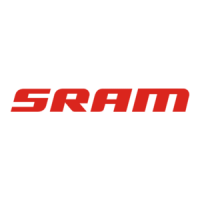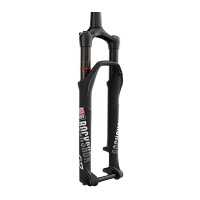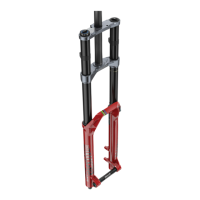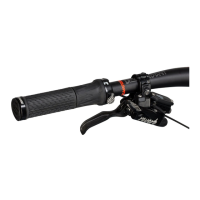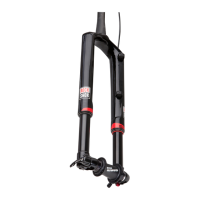Do you have a question about the SRAM ROCK SHOX Lyrik and is the answer not in the manual?
Preparing fork components by removing and cleaning them before service.
General guidelines for cleaning parts, replacing seals, and applying lubricant during servicing.
Crucial safety precautions to follow, emphasizing the use of protective gear during maintenance.
Instructions for detaching the lower leg during 50 or 200-hour service intervals.
Steps for removing, cleaning, and re-lubricating foam rings within the lower leg.
Correctly installing lubricated foam rings under the wiper seals in the lower leg.
Cleaning the lower leg interior and exterior, and removing old wiper seals.
Installing new foam rings and wiper seals using specialized installation tools.
Instructions for safely detaching the air spring assembly from the fork for maintenance.
Steps to remove the air spring top cap and its associated o-ring.
Detailed guide on safely removing the retaining ring from the air spring shaft.
Removing the seal head, wave spring, and top out bumper from the air spring shaft.
Cleaning the air piston and replacing its o-rings or quad ring seal.
Guide on installing Bottomless Tokens to modify the fork's air spring volume and ramp characteristics.
Assembling the top out bumper, wave spring, and seal head onto the air spring shaft.
Inserting the air spring assembly into the upper tube and positioning retaining washers.
Properly seating the retaining ring for the air spring assembly using specialized pliers.
Applying grease to the air spring shaft and filling the upper tube with suspension oil.
Installing the air spring top cap and adjuster knob, ensuring correct alignment and torque.
Steps for safely removing the Charger 2 damper assembly from the Lyrik fork.
Instructions for removing adjustment knobs, remote spool, and the damper top cap.
Steps for removing the rebound damper seal head assembly from the cartridge tube.
Replacing the glide ring on the piston and installing a new seal head with greased seals.
Cleaning the cartridge tube and compression damper assembly using specialized cleaner.
Filling the cartridge tube with suspension oil and purging trapped air bubbles from the bladder.
Installing the rebound damper piston and seal head, securing with specified torque.
Using the bleed syringe to pressurize and fill the damper assembly with oil.
Safely releasing pressure from the damper and installing the bleed screw.
Cycling the rebound shaft and cleaning the damper assembly after the bleed process.
Installing the Charger 2 damper assembly and tightening the top cap to the specified torque.
Installing the compression and low-speed adjuster knobs onto the damper, ensuring correct orientation.
Installing remote cable stop collar and spool for forks with remote adjustment systems.
Securing the cable stop collar set screw, referring to OneLoc manual for remote setup.
Steps for safely removing the Motion Control damper assembly from the Yari fork.
Removing the retaining ring and the rebound damper/shaft assembly from the fork's upper tube.
Removing the rebound damper piston and seal head from the Motion Control damper shaft.
Removing the old glide ring from the rebound damper and installing a new one.
Installing the seal head onto the shaft and threading the damper piston, securing with threadlocker.
Installing the retaining ring to secure the rebound damper assembly in the upper tube.
Filling the upper tube with the correct amount of suspension oil before damper installation.
Installing the compression damper, top cap, and adjuster knob, ensuring correct alignment.
Cleaning the upper tubes and applying grease to the inner surfaces of dust wiper seals.
Injecting suspension lube into lower legs and sliding the lower leg assembly onto the upper tubes.
Removing old crush washers from bottom bolts and installing new ones to prevent oil leaks.
Installing bottom bolts with correct torque and attaching the rebound knob.
Pressurizing the air spring and performing a final cleaning of the entire fork.
| Brand | SRAM |
|---|---|
| Model | ROCK SHOX Lyrik |
| Category | Bicycle Accessories |
| Language | English |
